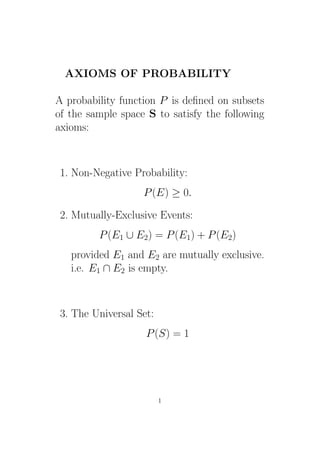
Axioms
- 1. AXIOMS OF PROBABILITY A probability function P is defined on subsets of the sample space S to satisfy the following axioms: 1. Non-Negative Probability: P (E) ≥ 0. 2. Mutually-Exclusive Events: P (E1 ∪ E2) = P (E1) + P (E2) provided E1 and E2 are mutually exclusive. i.e. E1 ∩ E2 is empty. 3. The Universal Set: P (S) = 1 1
- 2. Properties of Probability Theorem 1: Complementary Events For each E ⊂ S: P (E) = 1 − P (E) Proof: S =E∪E Now, E and E are mutually exclusive. i.e. E ∩ E is empty. Hence: P (S) = P (E ∪ E) = P (E) + P (E) (Axiom Also: 2) P (S) = 1 (Axiom 3) i.e. P (S) = P (E) + P (E) −→ 1 = P (E) + P (E) So: P (E) = 1 − P (E) 2
- 3. Properties of Probability Theorem 2: The Impossible Event/The Empty Set P (∅) = 0 where ∅ is the empty set Proof: S =S∪∅ Now: S and ∅ are mutually exclusive. i.e. S ∩ ∅ is empty. Hence: P (S) = P (S ∪ ∅) = P (S) + P (∅) (Axiom 2) Also: P (S) = 1 (Axiom 3) i.e. 1 = 1 + P (∅) i.e. P (∅) = 0. 3
- 4. Properties of Probability Theorem 3: If E1 and E2 are subsets of S such that E1 ⊂ E2 , then P (E1 ) ≤ P (E2 ) Proof: E2 = E1 ∪ (E 1 ∩ E2 ) Now, since E1 and E 1 ∩ E2 are mutually exclusive, P (E2 ) = P (E1 ) + P (E 1 ∩ E2 )Axiom2 ≥ P (E1 ) since P (E 1 ∩ E2 ) ≥ 0 from Axiom 1. 4
- 5. Properties of Probability Theorem 4: Range of Probability For each E ⊂ S 0 ≤ P (E) ≤ 1 Proof: Since, ∅⊂E⊂S then from Theorem 3, P (∅) ≤ P (E) ≤ P (S) 0 ≤ P (E) ≤ 1 5
- 6. Theorem 5: The Addition Law of Probability If E1 and E2 are subsets of S then P (E1 ∪ E2 ) = P (E1 ) + P (E2 ) − P (E1 ∩ E2 ) Proof: E1 ∪ E2 = E1 ∪ (E2 ∩ E 1 ) Now, since E1 and E2 ∩ E 1 are mutually exclusive, P (E1 ∪ E2 ) = P (E1 ) + P (E2 ∩ E 1 ) (1) (Axiom 2) Now E2 may be written as two mutually exclusive events as follows: E2 = (E2 ∩ E1 ) ∪ (E2 ∩ E 1 ) So P (E2 ) = P (E2 ∩ E1 ) + P (E2 ∩ E 1 ) (Axiom 2) Thus: P (E2 ∩ E 1 ) = P (E2 ) − P (E2 ∩ E1 ) (2) Inserting (2) in (1), we get P (E1 ∪ E2 ) = P (E1 ) + P (E2 ) − P (E1 ∩ E2 ) 6
- 7. Example: Of 200 employees of a company, a total of 120 smoke cigarettes: 60% of the smokers are male and 80% of the non smokers are male. What is the probability that an employee chosen at ran- dom: 1. is male or smokes cigarettes 2. is female or does not smoke cigarettes 3. either smokes or does not smoke 7
